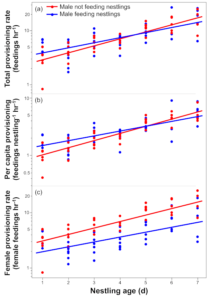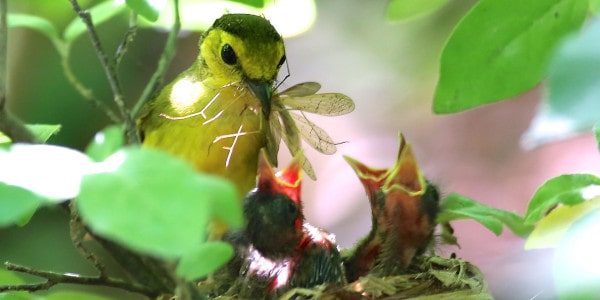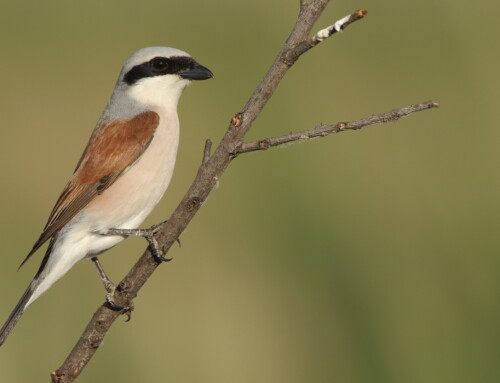LINKED PAPER
Females compensate for moult-associated male nest desertion in Hooded Warblers. Harrod, W. D., & Mumme, R. L. 2020. IBIS. DOI: 10.1111/ibi.12850. VIEW
Parenting is never an easy experience for mothers but it is especially difficult when fathers desert, leaving females to take care of offspring on their own. Male desertion occurs regularly in late-season nests of the Hooded Warbler (Setophaga citrina), a Neotropical migratory songbird found throughout much of the eastern United States. But when males desert, females are ready for the challenge; they effectively double their parenting efforts, and nestlings from deserted nests are fed, gain body mass, and survive at the same rates as young from biparental nests.
For most of their lengthy summer breeding season, Hooded Warblers care for their young biparentally, with males and females dividing the cost of parental care between them. In late July and early August, however, the end of nesting overlaps with the onset of the annual moult, particularly for males, as they begin moult 2-3 weeks earlier than females. And that’s when things get interesting.
Males in moult usually desert their late-season nestlings and fledglings, for two likely reasons. First, Hooded Warblers employ the odd moult strategy of dropping all 12 of their tail feathers at the same time they are also replacing multiple remiges, the flight feathers on the wings (see Fig. 1). Second, Hooded Warblers feed primarily on flying insects that they catch in an unusual way, by using their white tail patches and tail-flicking behaviour to startle prey hidden in vegetation. Consequently, males in tail moult have significantly diminished capabilities in both flight and foraging, probably making parental care costly, difficult, and potentially dangerous.

Our team examined how female Hooded Warblers respond to moult-associated male nest desertion. We used video recordings or direct observations from hides to measure the rate at which nestlings were provisioned. We also weighed nestlings daily to document growth and changes in body mass, and calculated the proportion of nestlings that survived to fledging. We then checked for differences between nests where both parents were feeding and nests where the male had deserted and only the female was feeding.
Nestlings from deserted nests were fed just as frequently as those from biparental nests (see Fig. 2), and some hard-working deserted females provisioned their young at the dizzying pace of 20 feedings per hour. However, the female provisioning response tended to undercompensate for male desertion when nestlings were young but overcompensate as nestlings aged (see Fig. 2), most likely because females with young nestlings have to spend considerable time brooding young and are therefore unable to devote enough time to foraging to compensate completely for the absent male. Regardless, nestlings from deserted nests gained mass and survived at the same rate as those from biparental nests.


The ability of females to completely compensate for male desertion of late-season nests is critical to understanding why desertion occurs so regularly in Hooded Warblers. In several other bird species, single-parent desertion occurs early in the nesting season, when deserters have the opportunity to breed again with a new partner. In such cases desertion can be advantageous even if it results in significant costs to the current brood. Late-season desertion, however, is a very different story; because opportunities to re-nest are absent, deserting males gain no immediate reproductive payoff, and desertion would be unlikely to evolve unless costs to current offspring can be minimized. Because female Hooded Warblers are ready, willing, and able to pick up the slack, desertion is therefore a viable no-cost option for moulting males.
While male nest desertion is not costly to either males or nestlings, it clearly places considerable demands on deserted females. Females effectively double their nestling provisioning efforts when males are absent (see Fig. 2c), and if the nest is successful this heavy female workload continues until the young reach nutritional independence about 35 days after hatching. Female Hooded Warblers make male desertion less burdensome, however, by producing smaller clutches late in the year, usually just 2-3 eggs compared to the 3-5 eggs typical of early-season nests. With small brood sizes, females are almost certainly in a much better position to manage the costs of extended late-season single-parent offspring care.
References
Chiver, I., Evans Ogden, L.J. & Stutchbury, B.J. 2020. Hooded Warbler (Setophaga citrina), version 1.0. In Rodewald, P.G. (ed) Birds of the World. Cornell Lab of Ornithology, Ithaca, NY. VIEW
Mumme, R.L. 2014. White tail spots and tail-flicking behavior enhance foraging performance in the Hooded Warbler. Auk: Ornith. Adv. 131: 141–149. VIEW
Mumme, R.L. 2018. The trade-off between molt and parental care in Hooded Warblers: simultaneous rectrix molt and uniparental desertion of late-season young. Auk: Ornith. Adv. 135: 427–438. VIEW
Székely, T., Webb, J.N., Houston, A.I. & McNamara, J.M. 1996. An evolutionary approach to offspring desertion in birds. Curr. Ornithol. 13: 271–330. VIEW
Image credit
Featured image: A female Hooded Warbler delivers a mouthful of crane flies to three eight-day-old nestlings. When moulting males desert, females effectively double their provisioning efforts, and nestlings are fed, gain weight, and survive at the same rate as nestlings in biparental nests. Photo © Mary Parker Sonis






